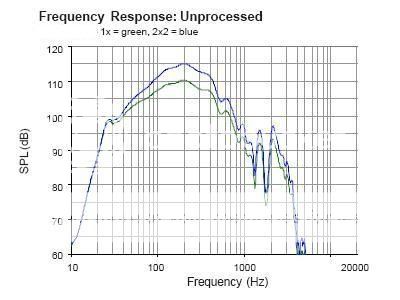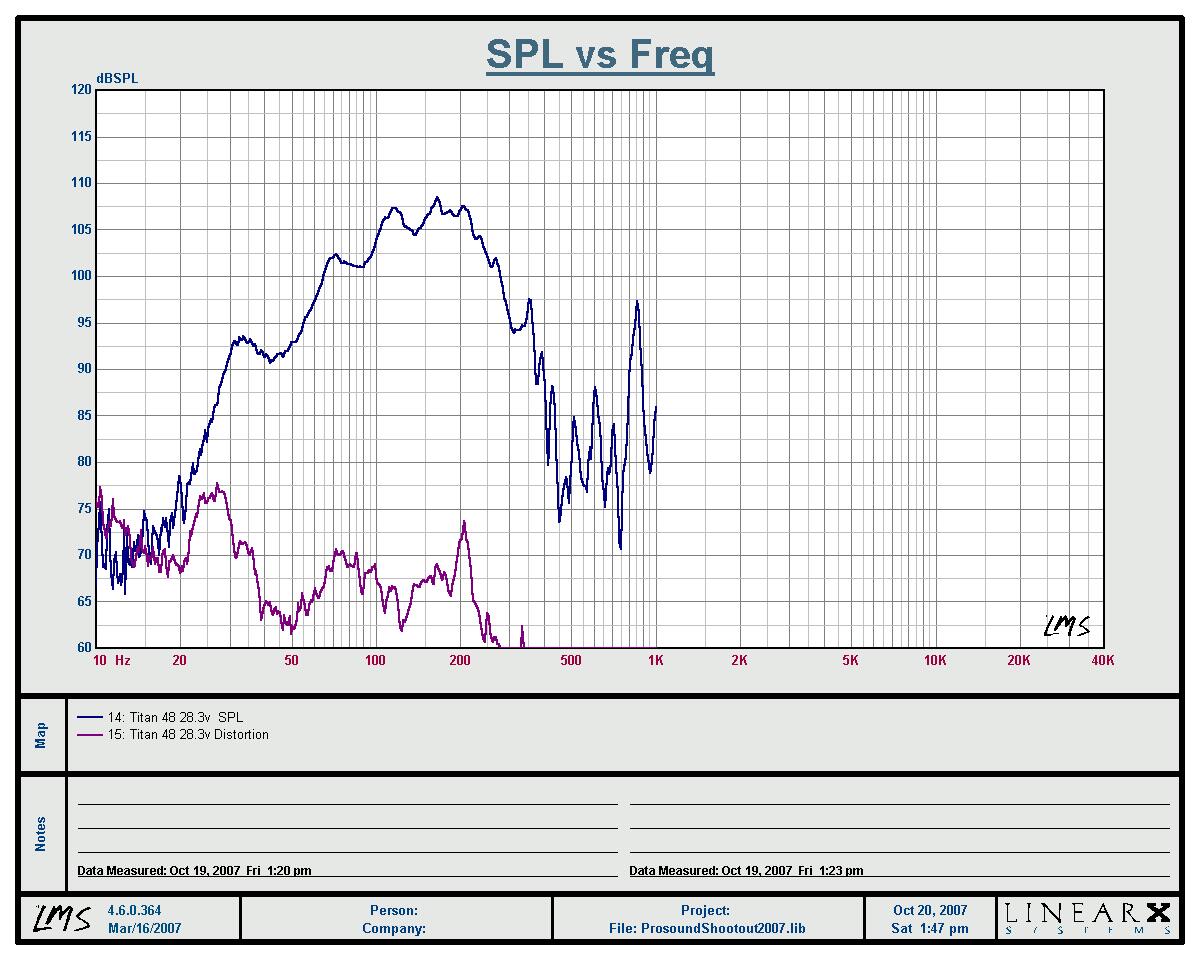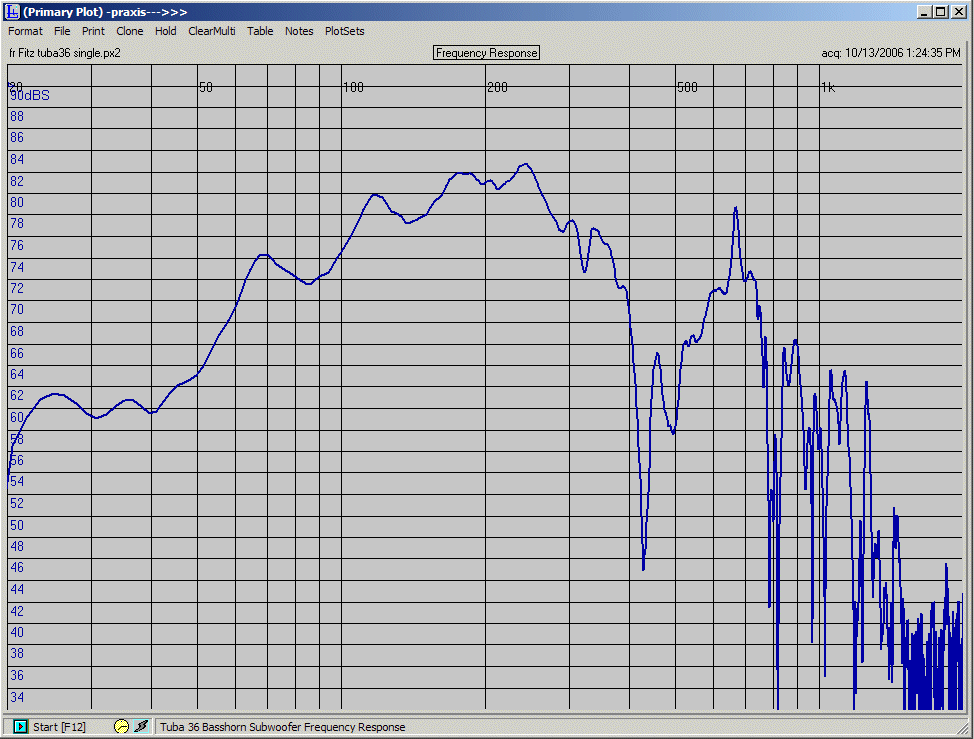what davy said:
However, I'll add one more bit of info. TH has a higher directivity than FLH, so if you are in the middle of a field, with no structures around -- that needs to be taken into consideration.
The bigger your stack of FLH, the higher it's directivity, and the less of an advantage goes to the TH.
So... FLH vs TH outdoors is like getting older.... it depends.
However, I'll add one more bit of info. TH has a higher directivity than FLH, so if you are in the middle of a field, with no structures around -- that needs to be taken into consideration.
The bigger your stack of FLH, the higher it's directivity, and the less of an advantage goes to the TH.
So... FLH vs TH outdoors is like getting older.... it depends.
For what folded horn?
What size can you accept? How many will be in the pile? What is the SPL goal? What is the cutoff (F3 and F10) you want?
Large cabinets are more efficient. More smaller cabs will equal lesser large cabs, but will cost more in terms of drivers. There's a delicate balance with the compromises one has to do.
What size can you accept? How many will be in the pile? What is the SPL goal? What is the cutoff (F3 and F10) you want?
Large cabinets are more efficient. More smaller cabs will equal lesser large cabs, but will cost more in terms of drivers. There's a delicate balance with the compromises one has to do.
"When you have multiple front loaded horns in a stack, they use the total mouth area and get deeper as well as louder (more efficient). "

The measure data from EAW on their KF940 seems to be at odds with your statement.
" do not know what f3 mean "
F3 is the point at which the system is 3dB down at.

The measure data from EAW on their KF940 seems to be at odds with your statement.
" do not know what f3 mean "
F3 is the point at which the system is 3dB down at.
Last edited:
The measure data from EAW on their KF940 seems to be at odds with your statement.
Go read the theory papers on how mouth areas become combined. Some people refer to it as a pressure bubble.
So why does it not show up in the measured data?
I don't care about other peoples broken data. If I had a magnifying glass to see the detail around 30-40hz I might be able to comment. But I do notice one thing, the graph doesn't flatten with two speakers. I gets more peaky. And how is the level at 30 Hz nearly the same? Even if all the subs were driven with the same total power an efficiency gain should be shown, but it isn't. Something is wrong with their chart.
Make your own measures and judge for yourself.
Last edited:
Ok, please comment on this set.
The more cabs that are added, the smother the upper part of the response becomes, and the deeper (55Hz for 4 vs 65Hz for one)

Even if the EAW graphs are power normalized (the BFM ones aren't), the 5 dB peak at 200 shouldn't be happening. Something is either wrong with their measurement conditions or we are assuming something they haven't stated and what it is, I have no idea.
But I'll say this, there is no way I would want a set of subs to not have an efficiency improvement in the low register when run as a pack. I also would not want a set of subs to have a peakier response as a stack. I would like to use front loaded horns and get that deeper response behavior when run as a pack.
Here's another example with DSL TH115s, but these graphs are power normalized and show that tapped horns don't get deeper when more are on the pile, just more efficient.
AVS Forum
What you'll want to look into is something called 'mutual coupling' and the behavior of front loaded horns.
The more cabs that are added, the smother the upper part of the response becomes, and the deeper (55Hz for 4 vs 65Hz for one)

Even if the EAW graphs are power normalized (the BFM ones aren't), the 5 dB peak at 200 shouldn't be happening. Something is either wrong with their measurement conditions or we are assuming something they haven't stated and what it is, I have no idea.
But I'll say this, there is no way I would want a set of subs to not have an efficiency improvement in the low register when run as a pack. I also would not want a set of subs to have a peakier response as a stack. I would like to use front loaded horns and get that deeper response behavior when run as a pack.
Here's another example with DSL TH115s, but these graphs are power normalized and show that tapped horns don't get deeper when more are on the pile, just more efficient.
AVS Forum
What you'll want to look into is something called 'mutual coupling' and the behavior of front loaded horns.
Hi!
Several times I see this measurement...
The PDF of EAWs product KF940 states:
"5. Environment: Measurements time-widowed and processed to eliminate room effects, approximating an anechoic environment. Data processed as anechoic or fractional space, as noted."
May be due this that we see no gain (deeper response) from one to four boxes due this?
May one box of the stack be out of eletrical phase?
Regards,
Several times I see this measurement...
The PDF of EAWs product KF940 states:
"5. Environment: Measurements time-widowed and processed to eliminate room effects, approximating an anechoic environment. Data processed as anechoic or fractional space, as noted."
May be due this that we see no gain (deeper response) from one to four boxes due this?
May one box of the stack be out of eletrical phase?
Regards,
Last edited:
Don't the graphs showing coupling of multiple horns in fact show that the total efficiency is hitting a ceiling and that this is what gives the flattening in response and the apparent extra extension?
Note that in the EAW graph going from 1 to 2 cabs gives an increase of almost 6db everywhere where as going from 2 to 4 and 4 to 8 only gives about 3db through much of the upper range. That would seem to correspond with a power doubling. The low freq's are still gaining 6db per doubling of cabs and power because the efficiency is much lower in that range. If you added enough cabs you would eventually end up with a flat line FR that extended lower and lower. It becomes a point of diminishing efficiency gains though. Look at the 1 cabinet graph and look at the amount of roll off from 55 to 25hz and then compare the amount of roll off of the 8 cab system over the same range. Seems to be a difference of maybe 1db.
Note that in the EAW graph going from 1 to 2 cabs gives an increase of almost 6db everywhere where as going from 2 to 4 and 4 to 8 only gives about 3db through much of the upper range. That would seem to correspond with a power doubling. The low freq's are still gaining 6db per doubling of cabs and power because the efficiency is much lower in that range. If you added enough cabs you would eventually end up with a flat line FR that extended lower and lower. It becomes a point of diminishing efficiency gains though. Look at the 1 cabinet graph and look at the amount of roll off from 55 to 25hz and then compare the amount of roll off of the 8 cab system over the same range. Seems to be a difference of maybe 1db.
Don't the graphs showing coupling of multiple horns in fact show that the total efficiency is hitting a ceiling and that this is what gives the flattening in response and the apparent extra extension?
Yes for the first part. Off hand, a 109 sensitivity is 50% efficiency. We want maximum. And no for second. It isn't apparent, it's real. There are two descriptions for this behavior I've read. #1, Mutual coupling causes a 'pressure bubble' to extend forward from the mouth causing additional loading to essentially lengthen the path length. #2, Each cabinet is now sharing the mouth area of the others, so the Cir parameter should be exceeding 1 at a lower point.
Note that in the EAW graph going from 1 to 2 cabs gives an increase of almost 6db everywhere where as going from 2 to 4 and 4 to 8 only gives about 3db through much of the upper range. That would seem to correspond with a power doubling. The low freq's are still gaining 6db per doubling of cabs and power because the efficiency is much lower in that range. If you added enough cabs you would eventually end up with a flat line FR that extended lower and lower. It becomes a point of diminishing efficiency gains though. Look at the 1 cabinet graph and look at the amount of roll off from 55 to 25hz and then compare the amount of roll off of the 8 cab system over the same range. Seems to be a difference of maybe 1db.

Actually, the EAW graph is for four cabs. And is behaving opposite to what I'd expect. And we don't know the conditions for the measurement. Hung array or half space? Is it power normalized? 10W total measured at 10 meters or what? IOW, 10W for the one cab and also 10W total for the four?
Unfortunately, my copy of handbook for sound engineers isn't in front of me, so I can't look up the math for speaker arrays and get that name they refer to for the efficiency ceiling to get my head straight on this.
What's odd here (aside from the Bill Fitzmaurice T48 graph not being power normalized) is that the greater differences in output are above 150Hz for the EAW with the T48 showing the opposite.
If you put any stock in BFM graphs, then I have a bridge I'd like to sell you.

An externally hosted image should be here but it was not working when we last tested it.

Tuba 36 is claimed to be 95dB at 40hz:
Actually measures 85dB (add 23dB for 1W/1M):

An externally hosted image should be here but it was not working when we last tested it.
Actually measures 85dB (add 23dB for 1W/1M):

Last edited:
- Status
- This old topic is closed. If you want to reopen this topic, contact a moderator using the "Report Post" button.
- Home
- Loudspeakers
- Subwoofers
- best sub for outdoor use